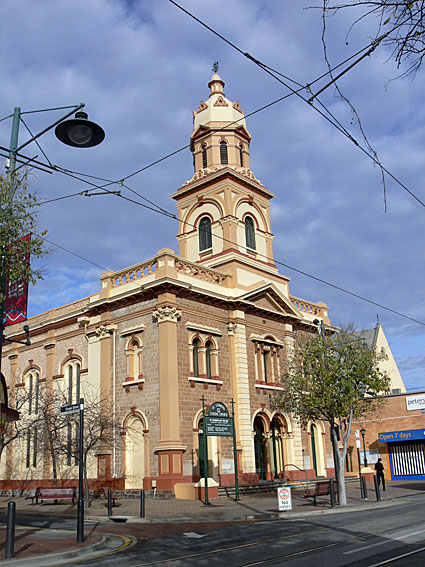
St Andrew's Uniting Church: exterior
[Photograph by John Maidment (15 June 2012)]

St Andrew's Uniting Church: exterior
[Photograph by John Maidment (15 June 2012)]
Historical and Technical Documentation by David Shield
© OHTA 2013 (last updated September 2013)
The current church of St Andrew's is the second in Jetty road and the third building of the Congregationalists in Glenelg. After meeting in the house of J.J. Barclay, the first congregational chapel was constructed in Gordon Street in 1849 but soon became too small. Rather than enlarge, it was decided to rebuild in a new location. This was because there was difficulty finding the original title deeds to the land and might have had future legal implications. Consequently, the building that now serves as the church hall was built, opening in 1859. This too became inadequate for the growing congregation and the current building was erected in 1880. Specific plans were made for an organ that followed three years later.
At the laying of the foundation stone for the second church in 1859, the Revd Palmer could not help alluding to the period when he commenced his ministrations there, and when his congregation consisted only of 40 persons, the place of worship looking like a large packing-case in a large puddle.1
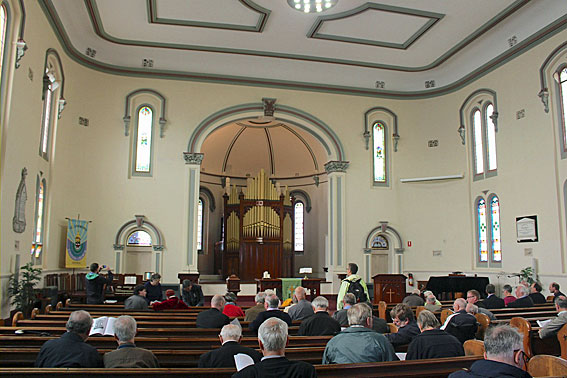
St Andrew's Uniting Church: interior
[Photograph by Trevor Bunning (1 October 2013)]
The new church was regarded as elegant and pleasing without being elaborate. Designed to seat 330 persons it was Gothic in design with internal dimensions of 60 x 36 feet. The sides had six buttressed bays each with a simple lancet light and there was a large rose window filling the upper part of the front gable. The entrance porch contained a tracery window on each side
The windows are beautifully executed in stone by Mr. Crook, …they are to be filled with designs in stained glass, now in preparation at the workshop of Mr. Brooks, North Adelaide.2
This building became "totally inadequate to serve the increasing importance and the advancing population of the town." The new church was built with the expectation of housing a pipe organ. A specific organ chamber 22 x 15ft 6 in being provided. The building was regarded as:
… certainly the finest place of worship in Glenelg. The church is 60 x 60 feet in the clear, with an organ chamber at the back 22 x 15 ft. 6 in., besides a vestry and ante-room, each 11 feet clear. The edifice, which is of the Italian style of architecture, possesses a very imposing appearance when viewed from without, and reflects great credit upon the designer. The architect is Mr. Garlick, and Mr. John Roberts is the builder. The total cost of the structure will be between £5,000 and £6,000.13
It was to be a year later before discussions were held with Fincham & Hobday. For nine months prior to the arrival of the new pipe organ a large reed organ belonging to the Mayor of Glenelg Mr Thomas King MP, member of the congregation, was used.4 The Deacons struck a hard bargain.

St Andrew's Uniting Church: organ
[Photograph by Trevor Bunning (1 October 2013)]
Negotiations with Arthur Hobday in relation to a new organ appear to have been raised late in 1881. By July the following year, Hobday writing to the Revd Basil Craig in Mt Gambier mentioned that "we are just about completing arrangements with the Congregational Church Glenelg for the construction of an organ to cost £500 - £600".5 In September, he reported to Fincham that "The Glenelg job is right but the case is not decided yet, the keyboards are to be bought forward, the organ is almost the same as the one I am finishing now less the Viola on Pedal organ".6 By July the following year it was finished and opened on the 27th of that month. The casework, with splayed sides, is similar to that provided by the Fincham firm for organs at Barkly Street Methodist Church, Ballarat, Victoria, the Methodist Church, Albert Park, Victoria, and St Patrick's Catholic Church, Albury, NSW.
Three organists were involved in the opening celebrations: T.H. Jones, of Brougham Place Congregational, W.R. Knox, of Flinders Street Presbyterian and Henry S. Rickards the church organist. The former were well known, playing "artistically" and "creditably" receiving hearty applause. Rickards was seen as a young and comparatively new artist.
The proceedings began with the hymn All Creatures that on Earth do Dwell. Jones played the Grand Offertoire in D (Batiste) and one of Beethoven's Romanza. Knox contributed Dawe's Offertoire in F, "I waited for the Lord", and Dawe's "Offertoire in forme de Masthe," (sic) . H. S. Rickards next gave Hill's Harvest Festival March and Archer's Impromptu in F. Perhaps the Mayor, Thomas King, considered the chosen pieces a little esoteric, as he suggested a piece well known to everyone might be played. The recital closed with the singing of a hymn by Isaac Watts played by Jones.7
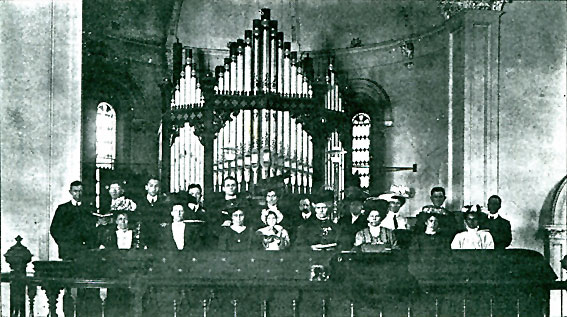
Congregational Church, Glenelg: choir and organ showing the original pipe decoration
[from the collection of David Shield]
Until the appointment of W.R. Knox, the organist's position was an honorary one. The first organists appear to be Henry S. Rickards and Joseph A. Kirkpatrick. Little is known of either man. Rickards married in 1889 and returned to Sydney. Unfortunately Kirkpatrick died at the young age of 49 from blood poisoning.8 With the death of Kirkpatrick the deacons immediately met to consider a replacement and a Mr Walker, C. Hedley Fisher and John Hambridge were considered.9 After a brief period filling-in, Mr Walker was paid an honorarium of £10 and it was to be W.R. Knox who was appointed and started on Sunday 19 February 1890 at a salary of £60 paid monthly.10 Knox was to stay for the next 12 years.11
Knox came from the Flinders Street Presbyterian Church to Glenelg for his health. It is interesting to note that by March 1897 Knox was dissatisfied with the instrument and sought to improve it. He set about raising funds by recitals.
The recital was in aid of the organ improvement fund, and judging by the response on Wednesday evening, the wishes of the church organist Mr. Knox, in this direction will shortly be carried out. The organ at the disposal of Mr. Knox is not a powerful one, but it possess (sic) a very nice tone, which enabled the player to give effect to many of the compositions interpreted on Wednesday evening.12
It is not known what the improvements were but they were left to others to institute. Knox returned to the metropolis of Adelaide in 1902.
J. French Lydal replaced Knox but was not destined to stay long. Accepting the position in December 1902,13 he left for Sydney in December the following year. During this time, after discussion with Dodd he provided the organ with a new pedal board as a gift. At the same time the deacons were induced to substitute water power for that of man and a hydraulic engine was acquired.14
J.A. Whiting took the position but succumbed to illness. In 1907 William Stewart Fotheringham became organist and remained till he was transferred in his job to Western Australia in 1921.
By 1910 Eustace Dodd had moved to Glenelg and was a member of the Congregation. In a response to the church's request that he continue his annual donation of three guineas towards the church funds, he felt he had to decline. He tied the amount to the cost of tuning the organ, pointing out that it negated any profit for him.15 Eustace was clearly in a position to give advice directly to the church and thereby endeavour to get work for the firm. He pointed out the water engine needed repair and asked the deacons to leave it to him to repair and he would see the cost was right.16
On the face of it there would appear to be little to differentiate the current tonal scheme from the original and yet several changes had already occurred prior to 1913. In that year Dodd had supplied a report to the deacons that not only outlined repairs but suggested some desirable changes as well. Apart from the removal of the bellows and feeders to be remade and releathered, there was also to be much refelting and rebushing of roller boards and action. Dodd also wished to reconstruct the tremulant and suggested the Swell Cornopean, Oboe and Great Clarinet be discarded because of their "Coarseness, poor scaling and inferior voicing". They were to be replaced with new ranks from Continental Specialists.
He then suggested the organ was tonally out of date and gave the Deacons specifications for a new organ and tonal scheme of 24 stops. Dodd did not get his wish before Fotheringham was transferred in his work to Western Australia and it was announced the George Macklin had been appointed organist and choirmaster at St Andrews.17
Further changes were suggested by Macklin. Dodd outlined the work in a letter to the deacons in 1921. The pedal board was to be replaced to conform with the later rules of the RCO London. The lever swell was to be replaced by a balanced swell pedal requiring the relocation of the composition pedals. The combinations themselves were also to be changed, "to suit Mr Macklin's wishes".18
A series of organists followed Macklin until the appointment of Edward Gare in 1934 who was to have oversight over major change to the organ. In a letter to the deacons J.E. Dodd had forwarded a plan of proposed alteration to organ and submitted quotation for the same of £253.119 It would seem the location and size of the choir in relation to the pulpit was untenable and presumably the idea was to extend the organ console. It was moved that an organ fund be started called organ and pulpit fund.20 After further reports and discussion tenders were called.21 Both local firms, J.E. Dodd and Gunstar Organ Works, provided quotations but they were to be overlooked.
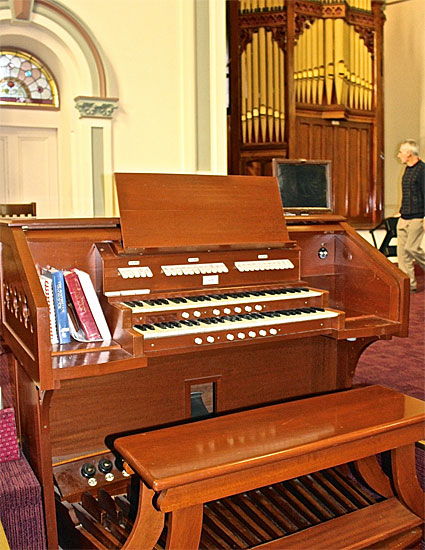
St Andrew's Uniting Church: present console
[Photograph by Trevor Bunning (1 October 2013)]
The work was carried out by Hill, Norman & Beard (Australia) Pty Ltd, of Clifton Hill, Victoria and was the firm's job number SA 74. This work included new electro-pneumatic action and a detached stopkey console. The original wind system was retained and the Fincham & Hobday tonal scheme remained unaltered. The organ was dedicated on Sunday 13 March 1938 by the Pastor, the Revd William Hawke. The evening service was preceded by a recital at 6.40pm by the organist Edward Gare who was to give a further recital the following Wednesday evening.22
Further work was carried out by Leith Jacob in 1985 who upgraded the electric action, fitted the console with new stopkeys and added a Bassoon 16ft to the Pedal Organ.
| GREAT Open diapason Claribel Dulciana Principal Flute Twelfth Harmonic Flute Clarinet Swell Sub to Great Swell to Great Swell Super to Great SWELL Double Open Diapason Open Diapason Gedackt Gemshorn Flageolet Mixture Cornopean Oboe Swell Sub Octave Swell Octave Tremulant PEDAL Open Diapason Bourdon Bassoon Great to Pedal Swell to Pedal |
8 8 8 4 4 2-2/3 2 8 16 8 8 4 2 III 8 8 16 16 16 |
(open) bottom 12 unenclosed tapered (17.19.22) |
Compass 56/30
5 thumb pistons to Great
5 thumb pistons to Swell
3 thumb pistons to Pedal
5 toe pistons to Great
5 toe pistons to Swell
Reversible thumb piston for Swell to Great
Reversible thumb piston for Great to Pedal
Reversible toe piston for Great to Pedal
Balanced swell pedal
1 Advertiser 19/4/1859 p.3
2 ibid 19/11/1859 p.1; ibid 9/12/1859 p.3
3 Register 4/10/1880 p.2s
4 Advertiser 21/7/1883 p.7; King's organ was by Mason & Hamlin and was described as "probably the finest reed organ in the city". Register 5/4/1886 p.7. King, a Congregationalist, was not a well man. In 1882 he spent eight months in England attempting to recuperate from illness. Though he had returned in better health the illness recurred, and in March 1885 he left again for England destined not to return. Advertiser 22/11/1886 p.5. In 1886 King's reed organ replaced the J.W. Wolff pipe organ of 1869 at St Francis Xavier Catholic Cathedral. Register 5/4/1886 p.7.
5 F&H Letters 12/64 Hobday to Craig, 21/7/1882
6 The specification referred to was for the Flinders St Presbyterian organ which had a Viola on the Pedal, Advertiser 27/10/1882 p.4; F&H letters 11/70 Hobday to Fincham, 16/9/1882
7 Advertiser 28/7/1883 p.6
8 Advertiser 2/8/1889 p.4; State Library of South Australia SRG 95 133 Glenelg Congregational Church Deacon's Meeting Minutes, 9/12/[1889] p.31
9 Deacon's Meetings op cit 27/8/1889 p.26; C.H. Fisher became the first President of the Adelaide Organ Club in 1931; John Hambridge was the grandfather of Ashleigh Tobin, the last Adelaide City Organist. Advertiser 2/1/1948 p.3
10 Deacon's Meetings op cit 28/1/[1890] p.35
11 Register 1/11/1902 p.4
12 Advertiser 25/3/1897 p.5
13 Deacon's Meeting op cit 3/12/[1901] p.94; ibid 31/12/1902 p.95
14 Register 15/6/1903 p.2
15 DLB vol 7 1909-1913, D.E. Dodd to Deacons 4/7/1910 p.287
16 DLB vol 8 1909-1914, D.E. Dodd to Deacons, 3/8/1910 p.64.
17 Register 30/7/1921 p.5
18 DLB vol 8 1909-1914 D.E. Dodd to Deacons 21/12/1921, pp.832-833
19 Deacon's Meetings, op cit 25/7/1934, p.302
20 Deacon's Meetings, op cit 29/1/1935, p.311
21 Deacon's Meetings, op cit 3/11/1936, p.340
22 Advertiser 14/3/1938 p.25

St Andrew's Uniting Church: Great pipework
showing remnants of Fincham & Hobday mechanical stop action
[Photograph by Trevor Bunning (1 October 2013)]
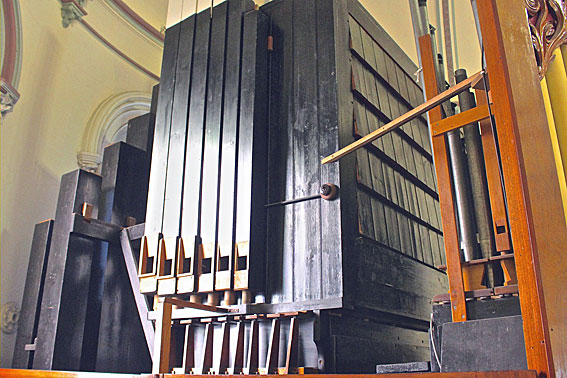
St Andrew's Uniting Church: Swell box, bass of Swell Double Diapason
and Pedal Open Diapason
[Photograph by Trevor Bunning (1 October 2013)]